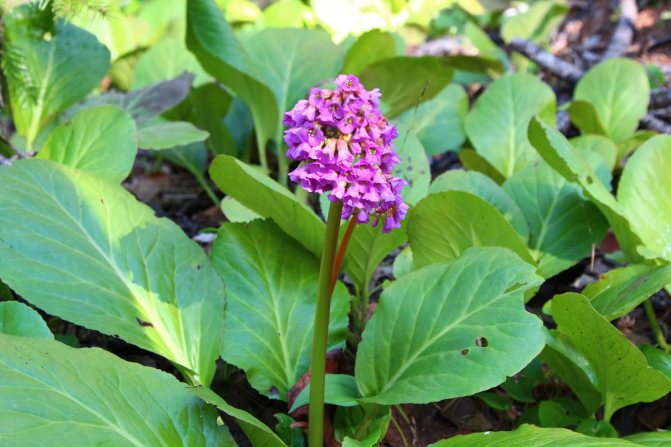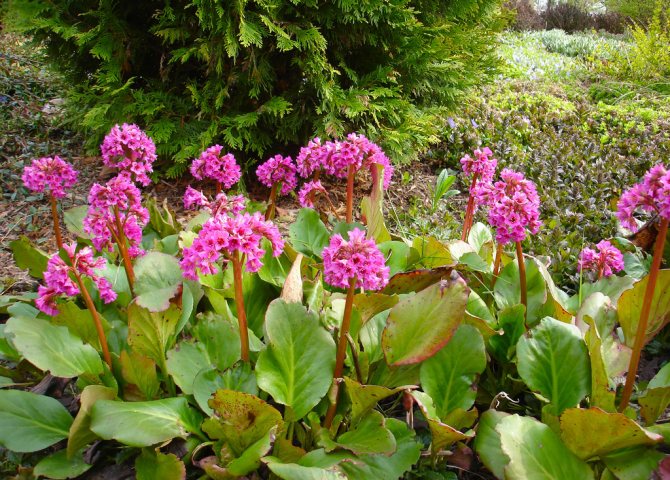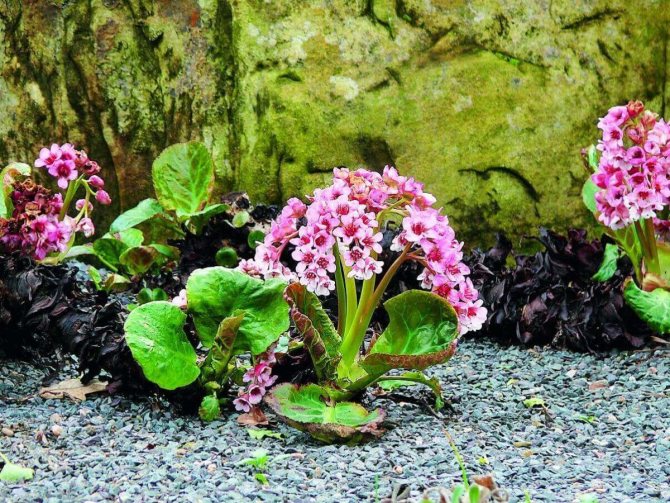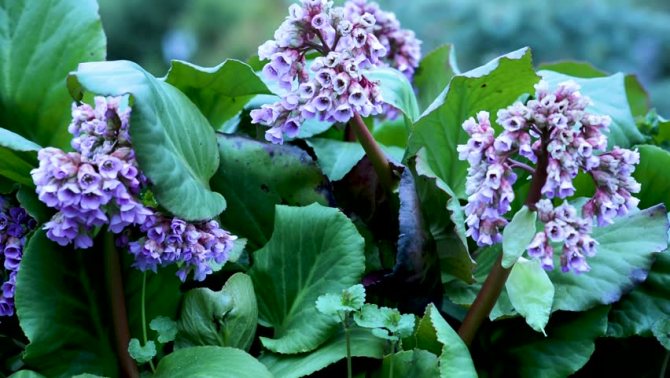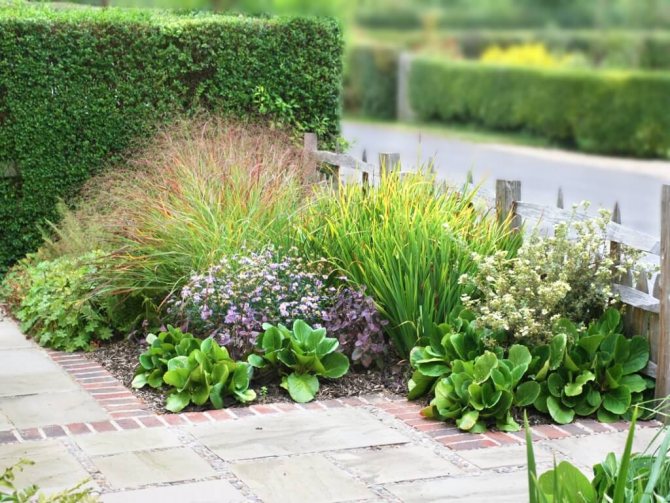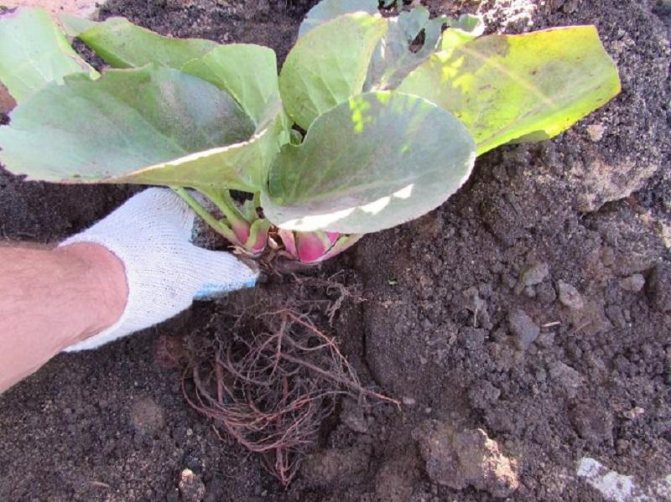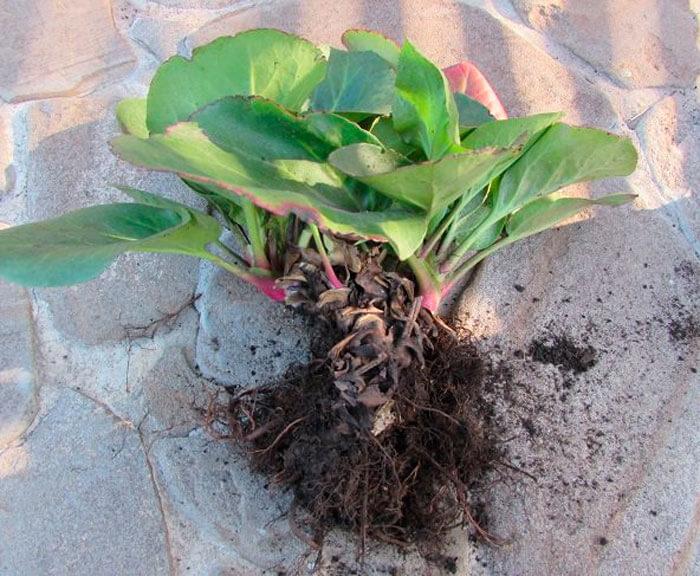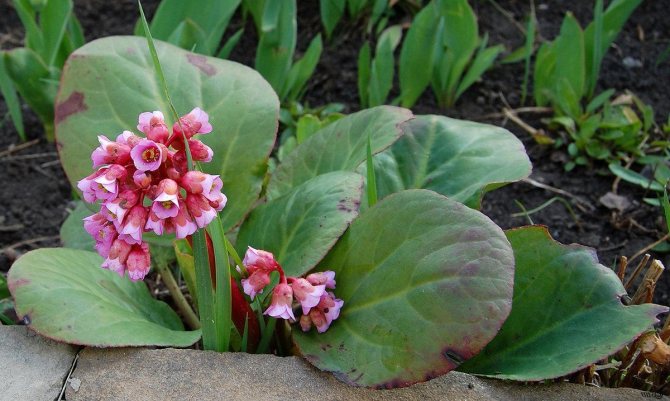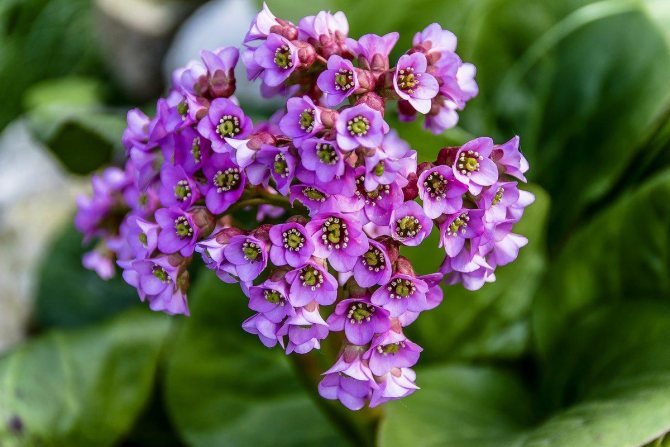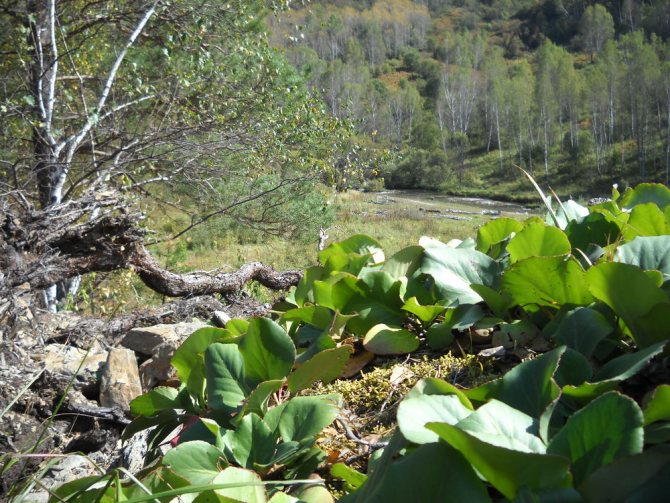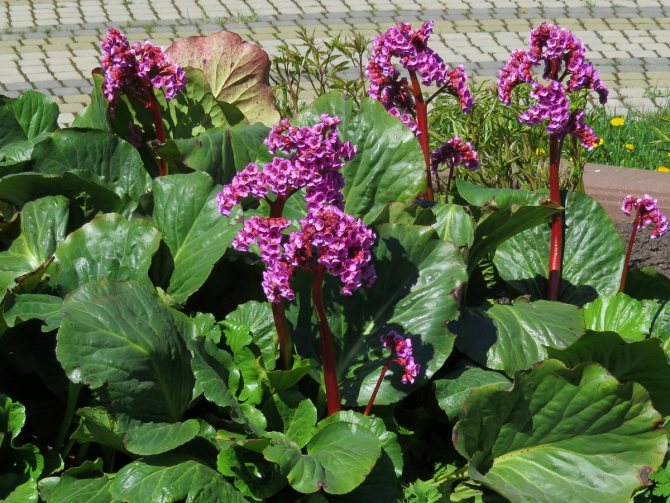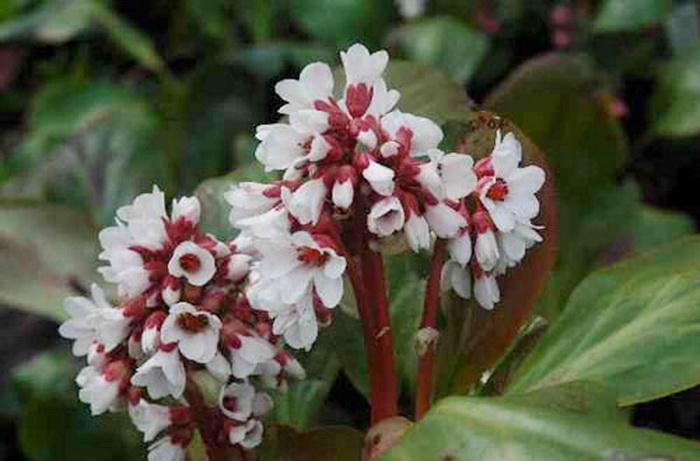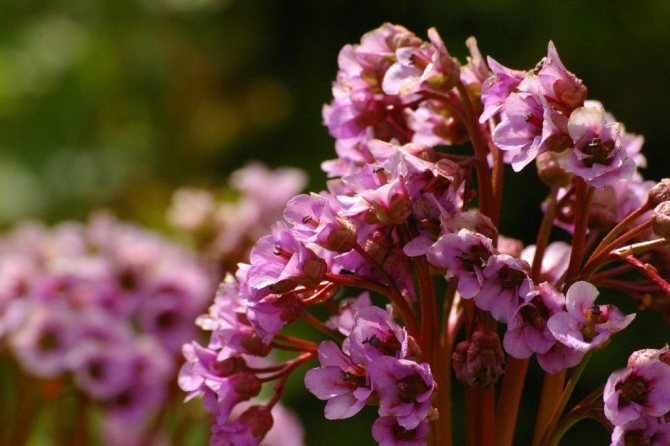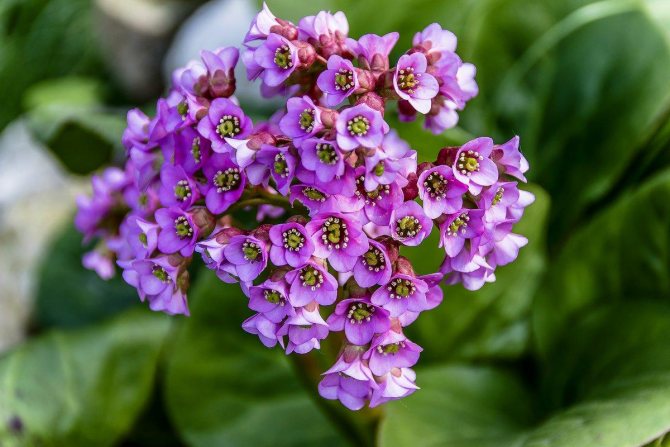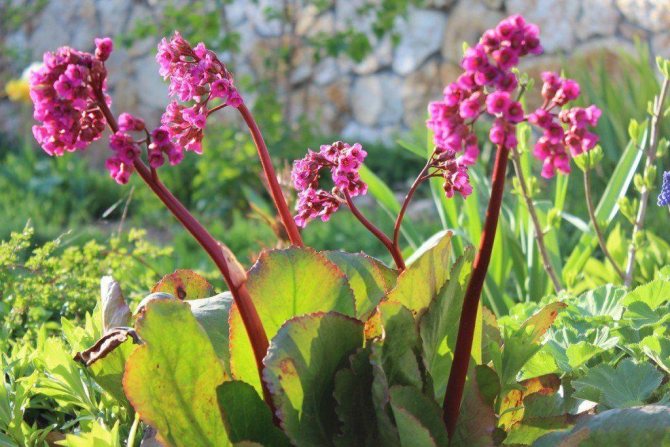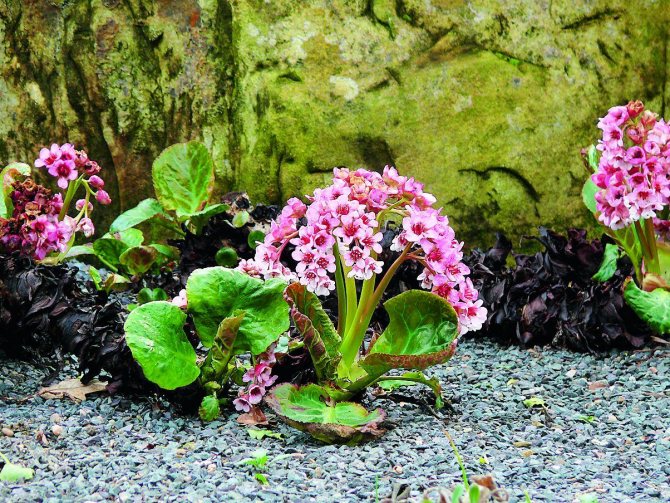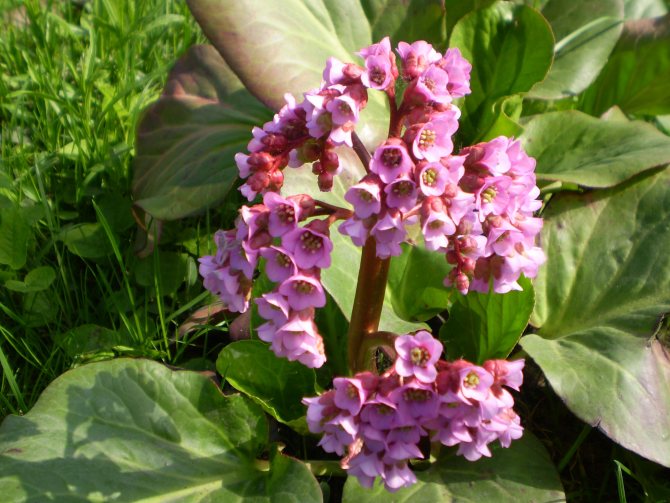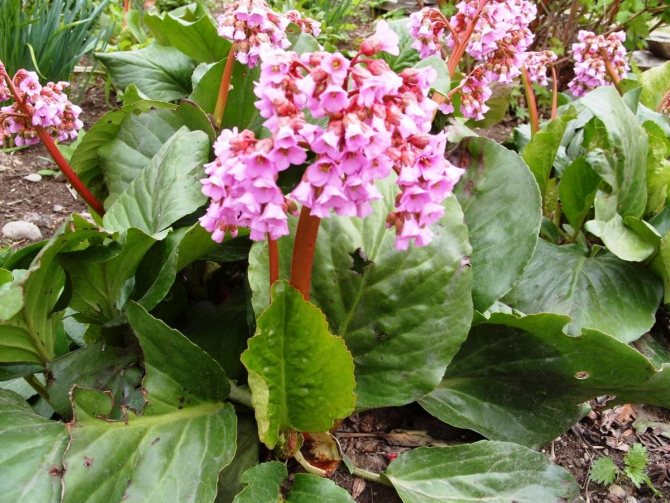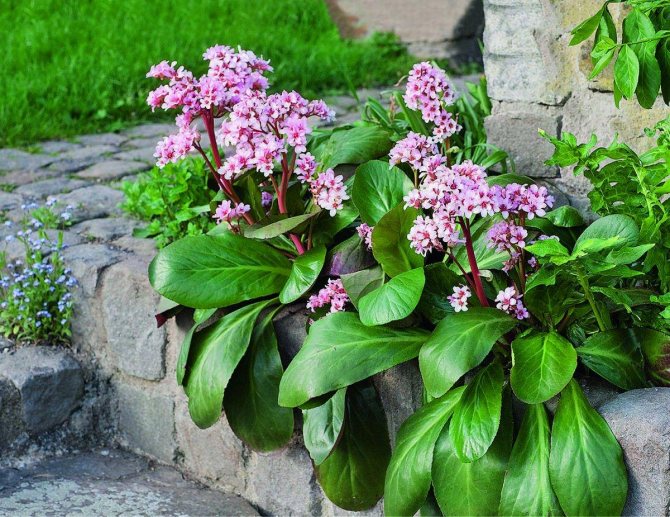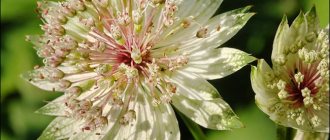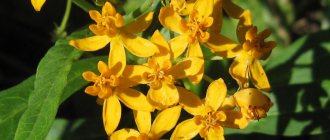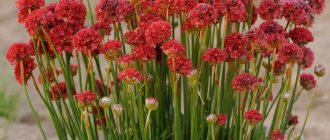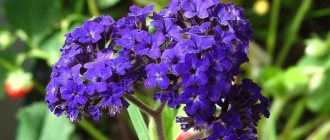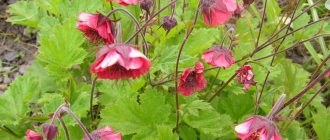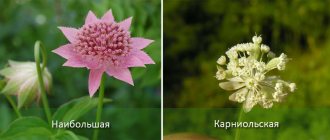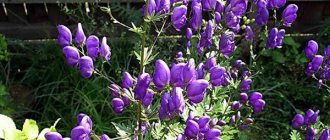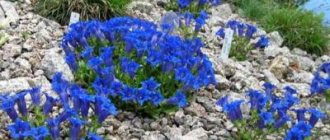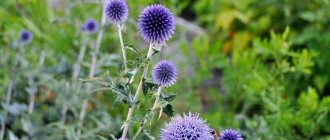The genus Bergenia was named by Konrad Mönch after the botanist Karl August von Bergen 1704-1759). The specific name corresponds to the Russian translation crassifolia - thick-leaved (crassus - thick and folium - leaf). Linnaeus in 1753 described it under the name Saxifraga crassifolia, and K. Fritsch attributed the plant to the genus Badan.
Currently, the genus Badan has about 11 species, but this number in different literary sources is quite different. The very species of thick-leaved bergenia also has many synonyms: Bergenia bifolia Moench, nom. illeg. (includes B. crassifolia); B. cordifolia (Haworth) Sternberg; B. coreana Nakai; B. crassifolia var. cordifolia (Haworth) A. Borissova; S. cordifolia Haworth; S. crassifolia var. elliptica Ledebour; S. crassifolia var. obovata Seringe.
General description of the plant
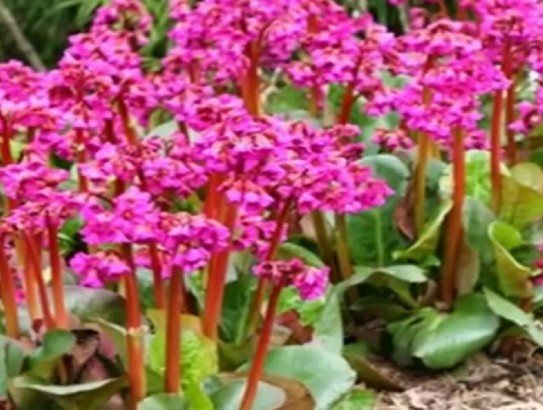
Badan is an evergreen herb that is familiar to many as the thick-leaved Saxifrage. The plant has a rather long horizontal creeping root, covered with many young shoots that can absorb water well. Sometimes the fleshy rhizome reaches more than two meters in length. Closer to the surface, the root system branches out to the sides.
Stem Saxifrage thick-leaved red, without leaves, plant height from twenty to seventy centimeters. Dark green large wide oval-shaped leaves are collected at the root in a dense rosette. The edges are solid with small, barely noticeable teeth. The length of the leaf sometimes reaches thirty-five centimeters, and the width is thirty. By autumn, the badan foliage becomes fiery red.
Badan usually blooms in May, but some early varieties of the plant bloom in April. On the still growing usually reddish peduncles, small five-membered flowers immediately bloom, which are collected in paniculate corymbose inflorescences. The bare bell-shaped calyx is divided up to the middle into five rounded parts, oval towards the top. The petals are rounded with numerous veins. Blooms are pink, purple-red, or white. The stamens are much longer than the calyx itself.
At the end of July, the plant has small black seeds. The fruit is an ellipsoidal dry capsule. Badan grows naturally in forests or on rocky slopes. The plant is most widespread in Kazakhstan, in the northern part of Mongolia, in the Urals, in Siberia, in the Khabarovsk Territory and Primorye.
Florists grow a plant to decorate flower beds. The culture is unpretentious and grows well on dry soils in shaded areas. Propagated by seed or dividing the bush in the fall.
Plant care
Like any garden culture, badan requires care, but it cannot be called burdensome. All that is needed for normal growth and fabulous flowering is timely watering, eliminating stagnant water and overflow, suitable feeding, periodic harvesting of falling leaves and mulching.
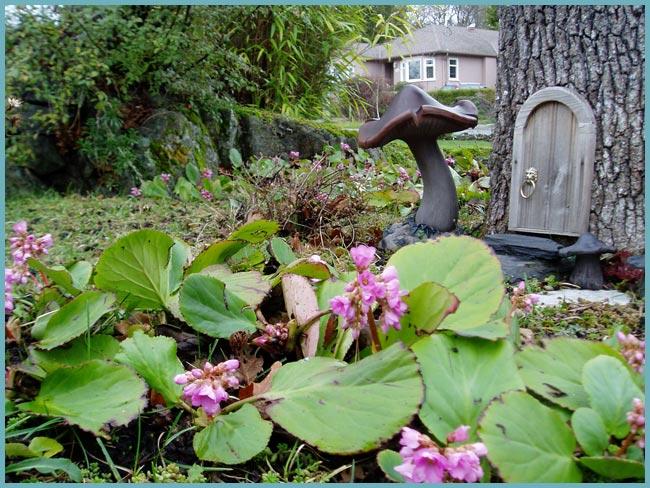

It is better to mulch the soil around the bush to ensure uniform evaporation of moisture
Important! In the spring, the berry needs to be cleaned of last year's shoots, get rid of dried foliage, and shorten the shoots a little.
If the plant was not planted in a prominent place in the backyard, then you can not clean the garden culture of last year's leaves: gradually falling off, they will cover the soil with a kind of protective layer, which will help preserve moisture in the ground and save the plant from overheating in the summer heat.
In one place, bergenia can grow quietly for about 10 years, while it does not require transplanting and is extremely resistant to frost on the soil.
Plant composition
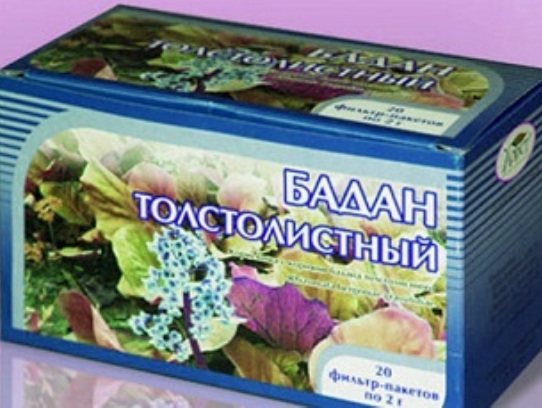

Badan root contains arbutin, which is a good natural antioxidant.The root system of the plant is enriched with:
- glucose;
- tannins;
- ascorbic acid;
- isocoumarin bergenin;
- starch;
- polyphenols.
Tannins in the root of an adult plant are up to twenty-seven percent. Also, this part of the culture contains sugar.
Badan leaves contain up to thirty-five percent of a mixture of pyrocatechol and pyrogallic tannins. The ground part of the plant contains the largest amount of arbutin, in addition, the leaves include:
- gallic acid;
- vitamin C;
- carotene;
- flavonoids;
- manganese;
- iron;
- copper;
- coumarins;
- tannins.
In addition, the plant contains essential oils and resins.
Badan in the garden: photo
Useful qualities of badan


In a plant, all parts are endowed with useful properties. The roots, leaves, flowers and even seeds are used medicinally. In general, the plant has many healing effects:
- antibacterial;
- diuretic;
- anti-inflammatory;
- healing;
- immunomodulatory;
- anti-stress;
- antipyretic;
- antineoplastic.
The leaves of the herb are used as an antimicrobial and hemostatic agent. From the root system, drugs are made that are used to treat stomatitis, cervical erosion and uterine bleeding. Badan infusions and decoctions are used to treat various ailments:
- pulmonary tuberculosis;
- diarrhea;
- throat diseases;
- headaches;
- rheumatism;
- diseases of the gastrointestinal tract;
- goiter;
- high blood pressure;
- kidney disease;
- pneumonia.
The medicinal plant is used in the complex treatment of dysentery, cancerous tumors and respiratory infections. In pharmacies, you can buy various drugs, which include badan. The dried root of the plant and the herb are also sold separately. Powder is made from rhizomes, which is sprinkled on wounds on the skin, compresses are applied for bruises and bruises.
Benefits for the female body
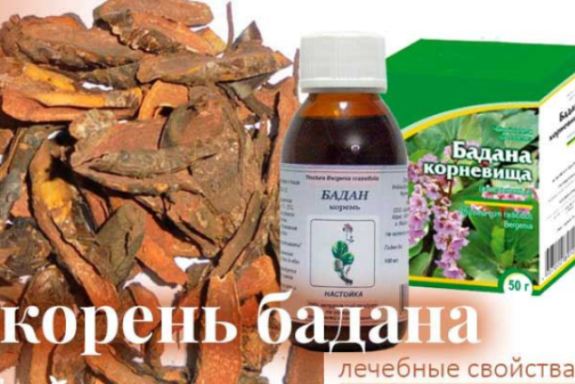

Badan root is an excellent remedy for many gynecological problems. It is used to treat thrush, fibroids and cervical erosion. Decoctions and infusions from the rhizome are effective for heavy menstruation and various inflammatory processes of the organs of the scarlet pelvis in women.
It is recommended to take a decoction to prevent bleeding. To prepare it, pour a glass of boiling water over three tablespoons of chopped rhizomes and cook for twenty-five minutes over low heat. You need to drink the remedy one sip several times a day.
Douching with a decoction from the roots of the grass is especially considered useful. To do this, the brewed liquid is diluted with water in a 1: 1 ratio. With the help of this procedure, inflammatory processes in the appendages, fibroids and erosion of the cervix are treated. For cystitis, an infusion of dried leaves and roots of bergenia is prepared for douching.
In cosmetology, the rhizome of herbaceous culture is used for acne, seborrheic dermatitis and to eliminate the problems of oily skin. Funds based on badan have an anti-inflammatory, antibacterial effect on the skin. For these purposes, a tincture of bergenia root on alcohol is often used. It's quite simple to prepare it:
- grind the badan rhizome;
- pour one tablespoon of raw materials with half a glass of alcohol;
- put in a dark place for six days.
Anti-inflammatory lotions are made from the finished infusion. It is applied to the face twice a week for fifteen minutes, after which it is washed off with clean water. In addition, a decoction from the plant perfectly improves blood circulation of the scalp and is used as a remedy for dandruff and to strengthen hair follicles.
Badan: combination with other plants
Badan, planted on flower beds, creates unusual compositions with such plants as:
- fern;
- mahonia;
- lungwort;
- juniper;
- astilba;
- hellebore.


Badan in the flowerbed
But with lilies of the valley, periwinkle and other undersized and creeping plants, it is better not to plant bergamo - it will not only get lost among them, but will also prevent them from growing, and it will itself be limited in space. The well-groomed incense growing under the spreading crown of any deciduous tree looks unusually picturesque and harmonious. Badan is no less beautiful, surrounded by spring bulbous flowers - delicate hyacinths, charming snowdrops and woods, bright crocuses.
Contraindications
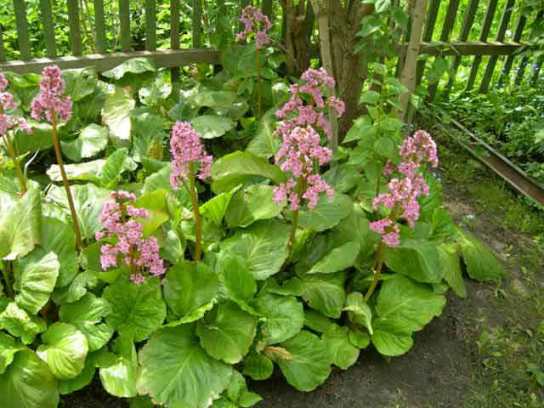

Badan as a medicinal culture contains many valuable elements, but there are still some contraindications to its use:
- not recommended for people with tachycardia;
- prohibited for patients prone to chronic constipation;
- it is impossible with increased blood clotting.
Broths or infusions of badan can significantly reduce blood pressure. Also, herbal treatment is not used for individual intolerance to the plant.
Description
This flower has creeping rhizomes, fleshy and thick. Their length is several meters, sometimes more than 3 meters. The stems of the plant are thick, leafless, pinkish, and closer to the peduncle are red, reaching no more than 50 cm in height.
The leaves that grow from the root rosette, hibernating under the snow, have a dark green tint, and turn red by autumn, They look like an almost rounded plate, large and thick, broadly oval, whole, naked, leathery. For this reason, bergenia is called thick-leaved. The flowers of the plant are small, regular in shape, very beautiful. These flowers do not have bracts, they gather in apical paniculate and corymbose inflorescences, usually in pairs on reddish pedicels without leaves. They have a bell-shaped cup, lilac-red, sometimes pink. But the stamens are about 2 times longer than the calyx itself. The fruits are a box, inside of which are black seeds after ripening.
Badan tea


From the leaves of the plant, a healing drink has long been prepared in China, Mongolia and Siberia. In this regard, such herbal tea is often referred to as Chigir or Mongolian. It has a rich cedar aroma and a dark brown hue.
For its preparation, they usually use dry berry leaves that have overwintered under the snow, which are saturated with the greatest amount of tannins and other elements useful for the body. Tea is brewed in ceramic dishes. To properly brew a medicinal drink, you must:
- chop a spoonful of dried leaves;
- pour half a liter of boiling water;
- insist for twenty minutes.
The finished tea has an astringent, pleasant taste and has tremendous benefits for the body:
- strengthens the walls of blood vessels;
- has anti-inflammatory, bactericidal, tonic and antipyretic effects;
- reduces high blood pressure;
- helps in the treatment of pneumonia;
- treats various gynecological ailments;
- helps to cope with diarrhea;
- relieves stressful consequences.
Related article: Fragrant Kupena (fragrant) - useful properties, description
Badan tea, saturated with vitamin C and various other equally valuable substances, is used for colds, as well as for rinsing the mouth with various inflammatory processes. To improve the taste of the drink, honey and lemon are used.
Mongolian tea is useful in treating bacterial infections in the intestines. In addition, it is used for the overall health of the body and increase the immune defense. But still, when using a drink for healing purposes, you should always remember about all the contraindications to the use of a medicinal plant. It is best to treat with herbal remedies under the supervision of a doctor.
Problems in growing and caring for bergenia
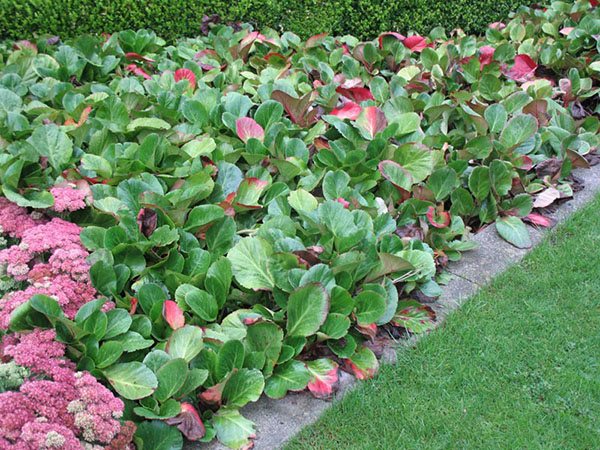

Most often, fungal diseases caused by crowding and high humidity are found on badan. Signs of such infections appear on the leaves in the form of brown or whitish spots, blackening or tissue necrosis.
The affected leaf plates dry out, and the disease grows. You can cope with the trouble when growing and caring for badan:
- spraying with systemic fungicides;
- the establishment of care and irrigation regime;
- rarefaction of landings in order to organize the inflow of fresh air to the bases of the outlets.
Among the pests that damage the plant, should be called slugs, nematodes and slobbering pennies. If insects can be dealt with with insecticide treatments, then worms are a big threat. The plants affected by them are dug up and, in order to prevent the spread of the nematode, are destroyed. The area where badan grew is repeatedly treated with insecticides against soil pests, and then left fallow until next year.
Traditional medicine recipes
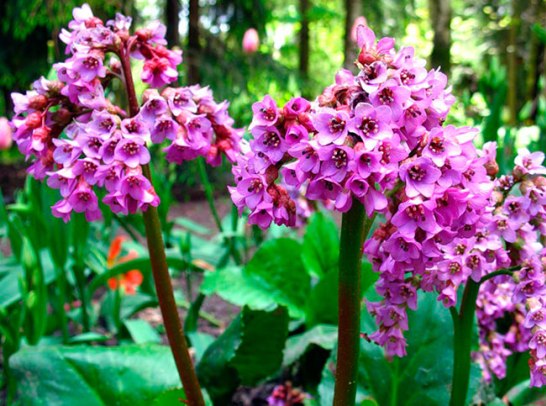

For a long time in Siberia, residents have used the dark brown root of badan not only for tinctures and other medicinal drinks, but also prepared side dishes from it and added to various dishes.
The valuable qualities of the plant are widely used in folk medicine. From the roots and the green part of the plant, infusions and decoctions are prepared, which help to heal many ailments:
- Broth. To prepare a medicinal drug, you need to pour two tablespoons of dry crushed roots of a plant with half a liter of water and cook for half an hour over low heat in a sealed vessel. After the broth, strain and cool. The finished healing drink is diluted with two glasses of water and taken three times a day, fifteen minutes before meals, two large spoons.
- Infusion. Place a spoonful of dry rhizomes and leaves of bergenia in a glass of boiling water and leave to brew for a couple of hours. Drink two spoons several times a day.
- Extract. Add two tablespoons of dry herbaceous rhizomes to two hundred milligrams of boiling water and cook over low heat with the lid closed until half of the liquid remains. The filtered extract is drunk three times a day, thirty drops each.
Such mixtures are successfully used as folk remedies for the treatment of various diseases:
- Stomatitis. Twenty milliliters of the extract is diluted in a glass of water and used to rinse the mouth. The procedure must be done several times a day.
- Rheumatism. For the treatment of the disease, an infusion from the roots of badan is used. One tablespoon of the healing potion should be taken four times a day.
- Hemorrhoids. It is recommended to use the decoction for warm sitz baths. The time for the water procedure should not exceed twenty at a bath temperature of up to thirty-eight degrees. The course of treatment is two weeks.
- Diarrhea. In case of indigestion, an infusion from the roots of bergenia is used. They drink it for two weeks, thirty milligrams three times a day.
- To strengthen the immune system. To increase the body's defenses, take tea or a cooled decoction from the leaves and flowers of the plant. You need to consume it before meals, two tablespoons four times a day.
A decoction of badan rhizomes is applied to wounds as a means of promoting healing.
Care features
When growing badan, despite the fact that the plant is unpretentious, it is necessary to adhere to some rules. The care recommendations are as follows:
- Watering is infrequent and moderate.
- For dividing the rhizomes, plants that are at least five years old are used.
- Mineral fertilizers are fed to the plant in spring during flowering and at the end. The rest of the time, feeding is not needed.
- Badan is a frost-resistant plant, but in winters with little snow it can freeze and then recover for a long time. To prevent this from happening, for the winter the soil around the plant is covered with a thick layer of mulch: dry fallen leaves, peat, pine needles.
If the planting site is chosen correctly, proper watering and care is provided, then the badan will gladly settle in a summer cottage, and for many years it will delight the owners and everyone around with its luxurious bright appearance and magnificent flowering.
Procurement and storage of medicinal raw materials
For medicinal purposes, the roots and leaves of the plant are mainly used. Harvesting of medicinal parts of badan is made separately:
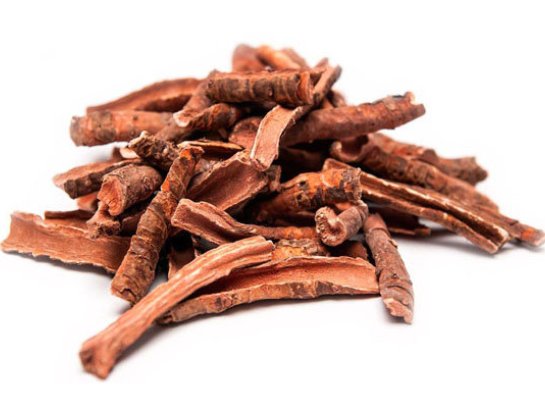

They are dug out of the ground after the flowering culture at the end of the first month of summer. The rhizomes are cleaned, washed and cut into small pieces. They are dried under a canopy on the street or in special dryers at a temperature of no more than thirty degrees, since a significant part of the useful components is lost during the high-temperature regime. Horses usually dry up to the desired condition within a month. Store the finished raw materials in dry sealed containers. Properly dried roots retain their valuable properties for three years.
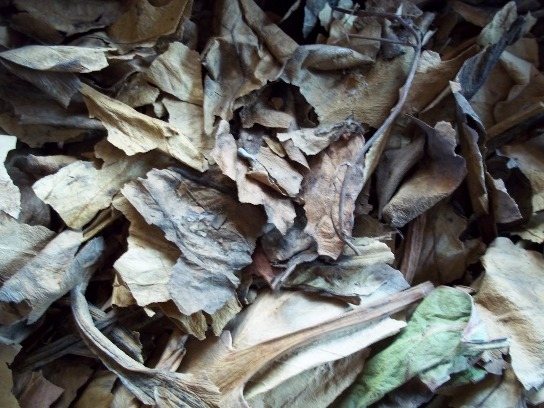

In the terrestrial part of the plant, the accumulation of useful elements occurs as the plant grows up. Therefore, the most valuable are the leaves that have wintered on culture for more than three winters. They are often dark brown in color with a loose structure and a pleasant, rich aroma. The leaves are dried under a canopy, spread out on paper or a wooden pallet in a small layer. The finished medicinal product is stored in dry paper bags or glass jars in dark places without moisture. The storage period for deciduous mass is no more than three years.
You can use the healing power of badan at any time of the year, observing all the rules for the preparation and storage of raw materials. Before using the plant as a therapeutic agent, you should always first review all restrictions on use, and it is better to consult with your doctor.
Badan, medicinal properties: video
Fertilizing and feeding berry
The plant is very responsive to properly selected feeding. It is recommended to use mineral fertilizers before and after the flowering of bergenia. 2-3 weeks after flowering, you can feed the plant: fertilizers in this case activate the process of maturation and aging of the leaves, which at this time are just beginning to change their color.
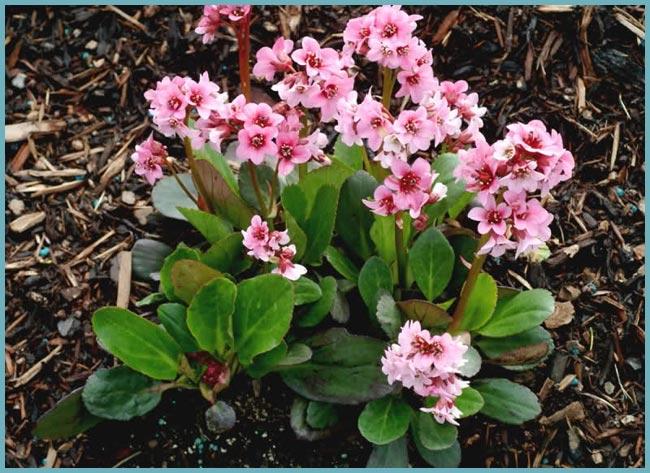

The plant should be fed with mineral compounds
Badan thick-leaved properties
Badan thick-leaved plant description, photo, medicinal properties and contraindications, pharmacognosy, planting and care, raw materials, rhizome leaf, root decoction
Latin name Bergenia crassifolia (L.) Fntsch


Badan thick-leaved - Bergenia crassifolia (L.) Fntsch
Badan thick-leaved perennial herb, with a thick creeping rhizome and numerous root lobes.
The rhizome is thick, with numerous adventitious roots, reaching a length of several meters.
The stem is leafless, up to 50 cm high.
Leaves are whole, glabrous, leathery, shiny, overwintering, collected in a basal rosette. The leaf blade is broadly elliptical or almost round, rounded or cordate at the base, obtuse or indistinctly dentate, 3 - 35 cm long, 2.5 - 30 cm wide, longer than the petiole.
The flowers are regular, five-membered, collected at the top of the stem in a dense paniculate-corymbose inflorescence. Calyx five-leafed, soldered at the base, five petals, ten stamens, semi-inferior two-celled ovary, Lilac-pink petals, ovate or rounded-ovate, at the base with a short and wide marigold, 10-12 mm long, 6-8 mm wide, 2 , 5 - 3 times as long as the lobes of the calyx.
Fruits are ellipsoidal dry capsules with numerous small seeds.
Blooms in May - July; seeds ripen in July-August.
Spread
Badan thick-leaved has a South Siberian range covering the mountains of Altai, Kuznetsk Alatau, Western and Eastern Sayan, the mountain systems of Tuva, the Baikal region and Transbaikalia. Enters the mountainous regions of Mongolia.
The western border of its range runs in the southwestern Altai, approximately at 83 ° N. sh. The northern border crosses the Kuznetsk Alatau, r. Yenisei (at 54 ° N), r. Kan (south of Kansk), then descends along the Eastern Sayan to the upper reaches of the Oka and, again ascending, follows north along the Baikal ridge, at 54 ° N. sh. crosses the lake. Baikal and at 54 ° 45 ′ n. sh. reaches the northern limit of its distribution. The eastern border of the range goes approximately along the Barguzinsky ridge, capturing the Ulan-Burgasy, Yablonovy, Malkhansky ridges and descends along 112 ° E. to the state border of the former USSR. The southern border passes through Buryatia, Tuva and Mongolian Altai. An isolated section of the badan's range is available in Aldan (Yakutia).
Badan thick-leaved belongs to the ecological group of plants of mesopetrophytes. It grows in the forest, subalpine and alpine belts at an altitude of 300 to 2000, sometimes even up to 2600 m above sea level. It is confined to well-drained stony soils, large-block taluses and placers, rocks and ancient moraines. Most often it grows on the slopes of the northern and northeastern exposures, it is found in rare forests, along the falls and river valleys. It grows less often on the southeastern and southwestern slopes, and on the southern slopes - only on char. Badan thick-leaved also grows on burnt-out areas in birch-aspen forests.
It is most widespread and abundant in dark coniferous forests (cedar, fir-cedar, spruce-cedar and larch-cedar) of the upper half of the forest belt, especially near the border of the forest, in the so-called badan forest types. Often, under these conditions, it forms continuous thickets.
Preparing garden badan for winter


Badans are hardy, however, in winters with little snow, some cultivars can freeze. So that in the spring the curtain does not look naked, and then does not recover for several years, the young, who did not have time to fully acclimatize, the plants are recommended to be insulated. This can be done with the help of a thick layer of mulch, for which fallen and dried leaves, spruce branches, and high-moor peat are used.
Planting and growing badan - video
Growing
Agrotechnics
Badan thick-leaved is an exceptionally frost-resistant and shade-tolerant plant with great biological adaptability, therefore it develops successfully in the most unfavorable conditions. Grows on stony and gravelly placers. It is bred in vegetable gardens. It is undemanding to soils, but it develops better on light, nutritious, well-drained soils. Prefers partial shade. Plants develop well with regular weeding, loosening of the soil, watering is necessary in dry times.
Related article: Garden quinoa - useful properties, description
Reproduction
Badan propagates both by seeds and vegetatively using rhizomes. It propagates better vegetatively - by dividing the bush or by segments of rhizomes, which are planted in nurseries. With seed reproduction, the bloom of bergenia occurs in two years.
Varieties
There are two varieties of thick-leaved bergenia — B. crassifolia var. cordifolia (Haw.) Boriss. and B. crassifolia var. baicalensis Boriss. The first has rounded large dark green leaves with a heart-shaped base, lighter flowers and a more compact inflorescence. Some authors consider this variety even a special species - heart-leaved berry - B. cordifolia (Haw.) Sternb. Occurs in Altai (near Lake Teletskoye, on the Bukhtarma River, etc.), as well as in the Sayan Mountains. B. crassifolia var. baicalensis Boriss. differs in wide-elliptical leaves, with a wedge-shaped base, as well as dark pink-violet flowers located in loose, with elongated branches, inflorescences. This species is confined to the shores of Lake Baikal. To Bergenia crassifolia. Pacific bergenia is close - Bergenia pacifica Cat., In which the leaf blade is ovoid or elliptical, 4-15 cm long, 3-9 cm wide.Petals are red, oblong, wedge-shaped-narrowed into a long nail, rounded from above, up to 2 cm long, 3 times the length of the calyx. Badan pacific is an endemic species, widespread in the Sikhote-Alin (between Sovetskaya Gavan and Nakhodka), less often in the mountains of the Khasansky district of the Primorsky Territory. Apparently, it can be used on a par with thick-leaved incense, but its medical use is not provided for in the technical documentation for the berry raw material.
Propagation of badan
Badan is propagated by dividing the bush (rhizomes) or seeds. Therefore, there are two ways to breed:
Growing up, bergenia forms new rosettes, which are easy to dig out together with the roots without damaging the mother plant. Reproduction begins after flowering (from June) and continues until the end of September. The rosettes are separated with a piece of rhizome, on which there must be at least three healthy buds. The leaves on the shoot are removed, leaving only 2-3 of the youngest leaves.
They are planted in pre-prepared holes, which should not be very deep, 6-8 cm is enough, a little sand can be poured onto the bottom for drainage. Planting depth - 3-5 cm. The soil under the plant is compacted and well watered.
With regular watering, the outlets take root easily, feeding can be started only a month after planting in a permanent place. In the first year, the plant gains strength, grows leaves and forms new shoots, and in the second (third) year it will please with its flowering.
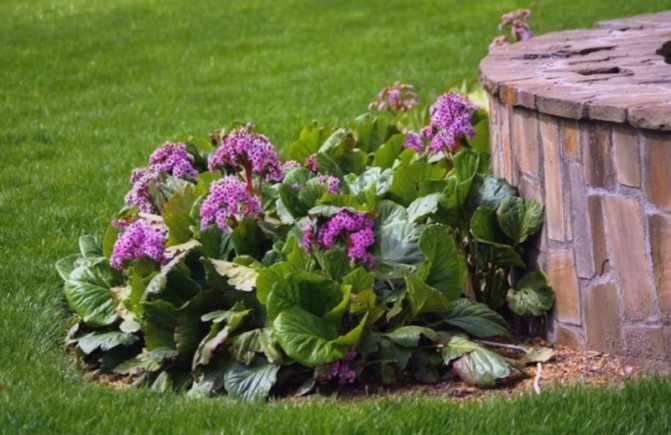

With generative propagation, seeds are sown in early spring in seedling containers. It is pre-mixed with sand and evenly distributed over the wet soil surface; it is not recommended to embed it deeply. The containers are taken out into the cold, buried in the snow, the seeds are stratified. At the end of the stratification process (in the second half of March), the boxes are placed in a warm room, the soil is periodically moderately moistened. Seedlings appear in 20-25 days.
When the first true leaf appears, the seedlings dive. At the end of May, young plants (12-15 cm) can be planted in open ground for growing. The soil should be loose and light. Seedlings are planted in a permanent place only the next year. Growing from seeds is a rather long process, the flowering of young plants is possible only after 2-3 years.
In one place, bergenia can grow for a long time, it does not need frequent transplantation. The plant is transplanted in the event that it is necessary to limit its growth on the site or new planting material is needed.
Application
Badan is used in the leather industry as a tanning agent for the production of light grades of leather, as well as for the impregnation of fishing nets.
Food use
Badan leaves that have lain under the snow for the winter are used in Altai as "Mongolian tea".
Use in landscape design
Badan is used as an ornamental plant in the design of alpine slides, in separate compositions, on rabatkas.
Medicinal use
Collection and processing of medicinal raw materials
Leaves and rhizomes are used as medicinal raw materials. Leaves are harvested in the summer-autumn period. Dried in the usual way. Badan rhizomes are harvested throughout the summer, until the end of the growing season. The collected rhizomes are cleaned of soil and small roots and dried. Harvested rhizomes, left in heaps for more than three days, easily rot. With improper drying of rhizomes, their quality is sharply reduced. Usually rhizomes are first dried on hangers, and then dried in dryers to an air-dry state. Drying time is about three weeks. During this time, the weight of the raw material is reduced by 30-35%. Fast drying reduces the amount of tannins, while slow drying helps to preserve them. Well-dried rhizomes have a light yellowish color at the fracture and contain up to 20 - 28% tannins.
Badan propagates both by seeds and vegetatively using rhizomes.Therefore, when harvesting, one should not allow a continuous collection of plants. It is necessary to leave 10-15% of plants intact in the thickets to ensure seed propagation of bergenia. In addition, the parts of the rhizomes left during harvesting are easily regenerated, which also contributes to the restoration of thickets.
... Raw materials are stored in bags or other closed containers for 4 years.
Badan thick-leaved medicinal properties
Leaves and rhizomes are used as medicinal raw materials. Badan preparations have anti-inflammatory, astringent, hemostatic and bactericidal effects, strengthen the walls of blood vessels, moderately lower blood pressure, slightly increase the heart rate. The plant is used for inflammatory diseases of the gastrointestinal tract, diarrhea and dysentery. In gynecological practice, a decoction of badan is used for heavy menstruation, bleeding after abortion, erosions of the cervix and leucorrhoea, taking orally or doing douching and baths. For dysentery, badan preparations are prescribed with antibiotics and sulfonamides. In dentistry, the gums are lubricated with a decoction, rinsing is prescribed. Powder root sprinkle wounds.
Pharmacological studies have shown that bergenia extract constricts blood vessels and seals their walls.
Application in official and traditional medicine
Liquid medicines are prepared as an extract or decoction. To prepare the extract, 3 tablespoons of rhizomes are poured with 1 glass of boiling water, half evaporated and filtered hot. Take 20-30 drops 3 times a day before meals. Douching is prescribed with an extract solution at the rate of 1 tablespoon per 0.5-1 liter of water. The volume of the liquid is adjusted to 1-1.5 liters. The procedure is done daily. The course of treatment is 2-3 weeks.
To prepare the broth, 1 tablespoon of crushed rhizomes is poured with 1 glass of hot water, boiled over low heat for 30 minutes, cooled at room temperature for 10 minutes, filtered and squeezed. Take 1 tablespoon 3 times daily before meals.
Propagation of badan
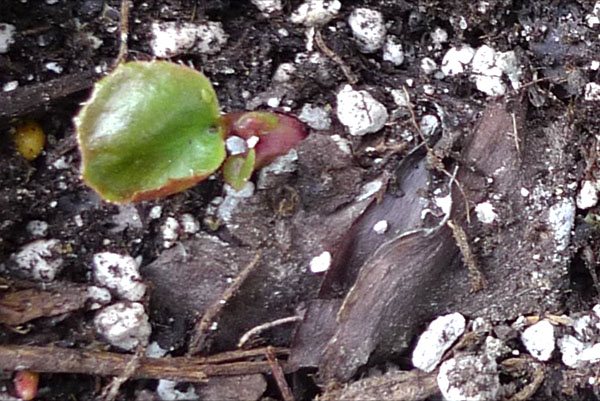

You can get young plants of badan on the site by sowing seeds of the variety you like or dividing an already grown plant.
Seed propagation of badan involves cold stratification.
Seeds sown into grooves with a depth of no more than 0.5 cm of a furrow are embedded in moistened soil and sent to the cold. Ideally, if the planting container is taken out into the open air and covered with snow, which will maintain optimal humidity and prevent future seedlings from freezing.
In early March, the container is placed in a warm place, in the light, but not in direct sunlight. At a temperature of 18–19 ºC and maintaining high humidity, the seeds begin to swell and hatch in 20–25 days.
Caring for the berry flower after planting involves watering and careful loosening of the soil around the seedlings. If the passages are too dense, they are thinned out, leaving one plant at a time of 3-5 cm.
In 45–55 days after sowing, young plants dive, spreading from each other at a distance of at least 6–7 cm. By June, you can determine where to plant badan. But before that, the seedlings are hardened, gradually increasing the residence time of the boxes with seedlings in the fresh air. In the first half of summer, the strongest seedlings are brought into the ground. The rest are transplanted in August.
Prescriptions for various diseases
Hemorrhoids, hemorrhoidal bleeding
Collection 1. Rhizomes of Potentilla erect - 1 part, rhizomes of calamus marsh - 1 part, rhizomes of thick-leaved badan - 1 part. 1 tablespoon of the mixture is poured with 1 glass of boiling water and boiled in a water bath for 15 minutes, infused for 30 minutes. They are filtering. Take 1/4 cup 3-4 times a day 20 minutes before meals for hemorrhoids.
To suppress poisons that have entered the stomach, soak thick-leaved incense in water, and also boil rhubarb leaves and apply as a compress to the stomach area.
Collection 1.Pour 2 tablespoons of crushed (black) leaves of bergenia thick-leaved with 1 cup boiling water, leave for 4 hours, drain. Drink 2 tablespoons 3 times a day after meals. At the same time, the infusion is used for oral baths before meals.
Collection 1. Take a few badan leaves that have lain under the snow for the winter (blackened), pour boiling water over, leave for 30 minutes, then strain, add sugar or honey to taste. Drink instead of tea. Perfectly quenches thirst.
Cultivation and reproduction
Badan grows well in the lower part of a rocky hill or on the northern or northwestern slope. This plant tolerates shade and can grow in partial shade areas. But in the sun, his leaves become somewhat smaller, which, in turn, reduces its decorative effect.
The soil is preferable well-drained and rich in organic matter, medium in texture. Usually berry grows in one place for many years, therefore, before planting, the site must be filled with organic fertilizers and compost must be applied at the rate of 1-2 buckets per 1 m 2.
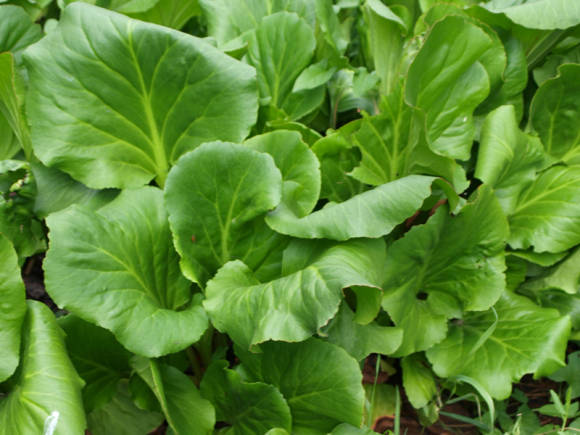

Most often, berry is propagated vegetatively, by pieces of rhizomes. Usually they take the top with a rosette of leaves and more or less developed adventitious roots. It is better to divide the plants at the beginning of autumn, then they have time to take root and in the spring they start growing almost immediately. When transplanting in spring, it is necessary to cut the flower stalks so that they do not deplete the plant, which already has weak roots, and, if necessary, water it. Very long rhizomes are cut into pieces 10-15 cm long and laid out in a groove on wet soil, covered and watered periodically. After a while, adventitious roots are formed, and dormant buds begin to grow. You can speed up the process of rooting and subsequent growth of a plant by soaking pieces of rhizomes before planting in a solution of heteroauxin, Zircon preparation, or dusting with Kornevin.
Badan practically does not suffer from pests and diseases. But watering in dry weather is desirable. Plants, of course, will not die, but their decorative effect is noticeably reduced.
Badan thick-leaved
An unpretentious plant with small beautiful flowers. In its natural environment, it is found in mountainous and forest areas, on scarce soils. It has a developed thick root used in folk medicine for the treatment of intestinal infections, as an antiseptic and wound healing agent for burns, skin lesions, in gynecological practice.


A valuable plant can sometimes be found in city parks and squares. It is chosen for landscaping for many reasons. It is not demanding on growing conditions and soils, since its natural habitat is the unfriendly Altai Mountains. It blooms with neat bright flowers, retains leaves for a long time, which turn brown by autumn. Such is he badan, the medicinal properties of which are rarely known to the inhabitants of cities. But this compact flower is worth taking a closer look at.
Diseases and pests
Thick-leaved incense is insensitive to pests and diseases. But this is only if all the conditions for the growth of the flower are met, otherwise the plant may suffer from spotting from time to time: brown spots with sharp outlines will appear on the leaves. In the future, the color of these spots will change from brown to brown-gray. On the underside of the leaves, a white, unhealthy bloom gradually forms. To get rid of a fungal disease, it is enough to cut off diseased leaves or spray with Bordeaux liquid composition, foundation or preparations with a high copper content.
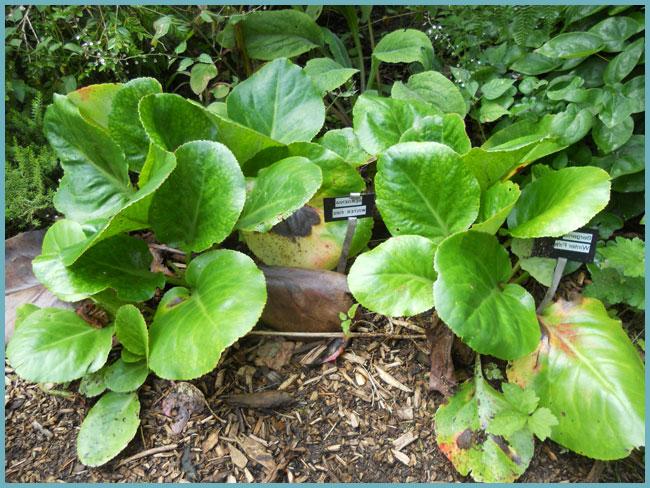

Badan disease - spotting
Features of badan
Outwardly, the plant resembles a violet, only the size of the flowers is smaller. Bushes rarely grow more than fifty centimeters in height. Their leaves are round, rich green, shiny and fleshy, collected in a rosette directly from the soil.
The stem is naked, only at the very tip of it are flowers in the form of open bells, lilac-red. Flowers are collected in inflorescences, crowning the flowering arrow. The flowering period of the culture is May and June, after which the fruit-boxes are formed from the flowers.
Related article: Banana - useful properties, description
Despite its small size, the culture has a massive root. The length of the badan rhizomes reaches one meter, and at the surface of the soil, their diameter is often thirty or more centimeters. The presence of such a developed root system allows the plant to survive and even bloom where other flower crops cannot grow: in Altai, in the mountainous terrain of Central Asia.
Collection and procurement
Traditional medicine uses Pacific incense (thick-leaved) completely, taking into account the valuable qualities of roots and leaves. They are collected at different times.
- Rhizome. Dug up in June, after the flowering of the plant. A large rhizome is cleaned, small and damaged parts are removed, washed and crushed in pieces no more than twenty centimeters in length. It is dried by placing it on newspapers under a canopy or in dryers, setting the temperature to no more than thirty degrees for three weeks. For the root of the berry plant, slow drying is necessary with a slight increase in temperature, since at high temperature conditions during drying, the main part of the active substances is lost. After the harvesting cycle, the medicinal properties of badan persist for four years.
- Leaves. As it grows up, the plant accumulates more valuable substances in the leaves. Therefore, in folk medicine, leaves are valued that have survived on the bush for at least three winters. They are characterized by a loose structure, often black-brown in color. But it is these leaves that have a specific, pleasant aroma that they acquire in the process of many years of natural fermentation. Badan tea made from three-year-old leaves and older is a more valuable product than brewed from young leaves. The latter have a mild, barely perceptible odor that intensifies after wintering. It was during this period that they are collected, paying attention to dark, brown leaves. After collecting, they are dried on paper under a canopy.
Casting badan can be used immediately after collection. Dry leaves can form the basis of a tonic tea or be used as a medicinal raw material.
The plant is so unpretentious that it can be grown in a garden or vegetable garden. Shady and semi-shady areas with dried soil are suitable for him. Propagation of badan is carried out by dividing from an adult bush in the fall.
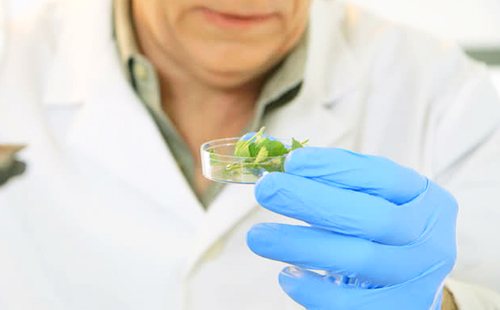

Composition and properties
The rhizome accumulates tannins, the level of which is up to twenty-eight percent, of which up to ten percent are highly effective tannins. Tannins are astringent compounds that have a versatile effect: hemostatic, inhibiting the secretion of glands, antiseptic. The root also contains the glycoside bergenin, sugars and free polyphenols.
In the leaves, tannins are also present, but in a lower concentration. The older the plant, the less tannins there will be in its foliage. But the content of another, no less valuable component increases with the age of the culture. The beneficial properties of badan are associated with the content of arbutin glycoside in it, the level of which is up to twenty percent. This substance has a pronounced antiseptic effect.
The effect of arbutin on the human body is not fully understood. There is evidence that the substance may be a source of carcinogenic hazard when ingested and associated metabolic reactions in the intestine. According to other sources, the substance can be used in oncology in order to reduce the intensity of the development of neoplasms and prevent cancer. Such data are cited in a study by specialists from the German Institute of The German Institute of Food Research.
Landing in open ground
Badan has a powerful root system. The roots are close to the surface or above the soil. The root rosette is large, the leaves are dense and leathery, bright green in color. In autumn, the leaves of some species acquire a burgundy, brown or bronze hue.
It begins to bloom from the end of March, and flowering can continue until the end of May. Flowers are collected in pink, purple or white inflorescences on a powerful peduncle. Badan is beautiful as a single plant or in group plantings with other perennials. For example, surrounded by hyacinths.
The flower is quite hardy and unpretentious, with proper care it grows well, therefore, with a little effort, even a novice gardener can not find it difficult to grow an incense in the country or on a personal plot.
When planting, it is important to choose the right place. The soil should be slightly alkaline, but in areas with a slightly acidic reaction, the plant can grow and bloom. In this case, the following conditions must be observed:
- light loose soil;
- penumbra;
- lack of stagnant moisture.
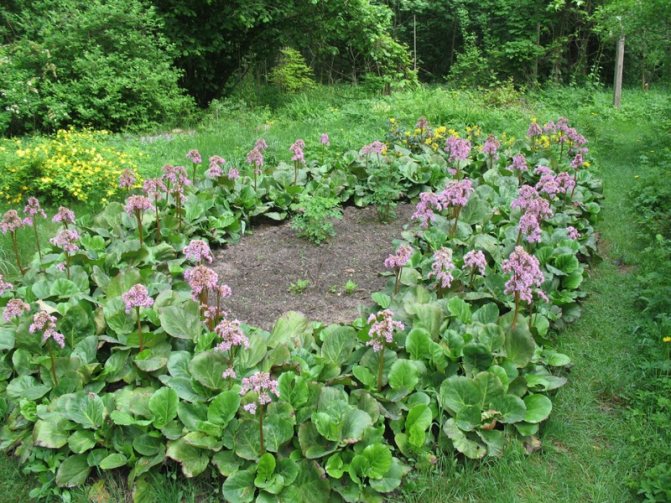

Badan is undemanding to light, prefers partial shade. Can be planted in places that are only illuminated by the sun in the morning or evening hours. When planted in full shade, the bush can grow and multiply, but will not bloom.
Planting in sunny areas is possible, but the soil under the plant is mulched. Cover with organic mulch (mature compost, pine needles, sawdust, straw) or inorganic (expanded clay). It is important to monitor soil moisture and water the berry well.
The soil should be light and loose. The plant does not tolerate spring stagnation of moisture, the rhizome can rot. To prevent this from happening, it is important to ensure good drainage during planting - add a little sand to the bottom of the hole.
The use of thick-leaved badan
Thanks to tannins, medicinal raw materials have a wide range of effects on the body. Its anti-inflammatory effect, actively astringent and inhibiting the development of pathogenic flora, has been proven. The plant extract thickens tissues, and when applied topically, causes the effect of vasoconstriction. When taken orally, it has a tonic effect on the cardiovascular system and reduces blood pressure.
The use of thick-leaved bergenia is effective in the following areas.
- Diarrhea, infectious diseases of the digestive tract. Tannins are active against pathogens of intestinal infections. When combined with antibiotics of the sulfanilamide series, they are highly effective in suppressing the causative agents of dysentery.
- Gynecology. The hemostatic and anti-inflammatory properties of bergenia make it possible to use it in gynecological practice. Recommended for the treatment of heavy menstruation arising against the background of inflammatory processes, fibroids, uterine fibroids. Stimulates the healing of cervical erosion.
- Hemorrhoidal bleeding. In the form of lotions when used externally, it reduces vascular permeability, reduces tissue edema and the severity of local bleeding of hemorrhagic nodes.
- Dentistry. Badan thick-leaved - an effective remedy for inflammatory diseases of the mucous membranes, oral cavity. Recommended as a disinfectant rinse for gingivitis, stomatitis.
Medicinal raw materials are used for external and internal drugs. When applied externally as a wound-healing drug, badan has no contraindications. If used internally, consult a physician, as there is a risk of lowering pressure. In small quantities, it can be used regularly as a delicious, tonic tea.


Cosmetological tincture
The use of badan root in cosmetology helps in solving the problems of oily skin, prone to inflammatory processes, the appearance of defects. The tool reduces the severity of inflammation, normalizes the skin microflora, and promotes wound healing.
- Grind the rhizome, use a tablespoon of raw materials.
- Fill with alcohol in a volume of one hundred milliliters.
- Leave in a dark place for five days.
This tincture is applied in the form of lotions on the face twice a week. Apply the anti-inflammatory mask for fifteen minutes.
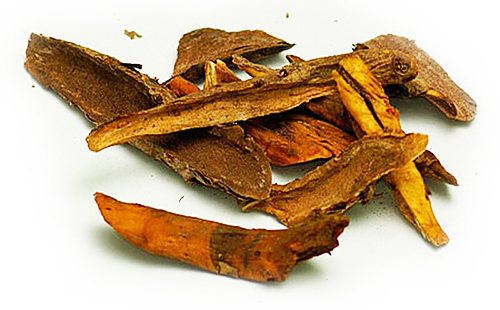

Decoction for dysentery, diarrhea
As a remedy for diarrhea, to improve the condition with intestinal infections, a decoction of badan root is used. It quickly relieves the condition due to its complex effects: astringent, hemostatic and anti-inflammatory.
- Grind the rhizome, use a tablespoon of raw materials.
- Pour two hundred milliliters of boiling water.
- Place in a water bath and steam for thirty minutes.
- Refrigerate, strain.
- Squeeze the raw materials into the drained broth, add boiled water to a volume of two hundred milliliters.
This recipe will help with diseases of the gastrointestinal tract, the treatment of infectious intestinal diseases. The broth should be taken up to three times a day, two tablespoons. During the treatment of diarrhea, dysentery, limit the diet, increase the amount of fluid you drink.
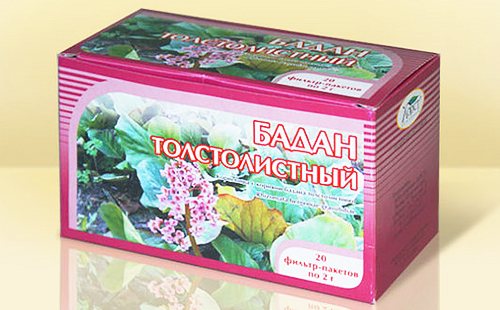

Wound healing extract
Means for external and internal use. Recommended for use in gynecology with heavy bleeding of an inflammatory nature. When used externally, it accelerates wound healing.
- Chop the rhizome and leaves, mix. Use three tablespoons of raw materials.
- Pour in boiling water in a volume of two hundred milliliters.
- Protome over low heat, evaporating the composition to half.
- Squeeze out the raw materials, strain the composition.
The liquid extract should be taken up to three times a day, thirty drops. When used in the form of lotions, a soft tissue is impregnated with a warm agent and applied to the affected skin.
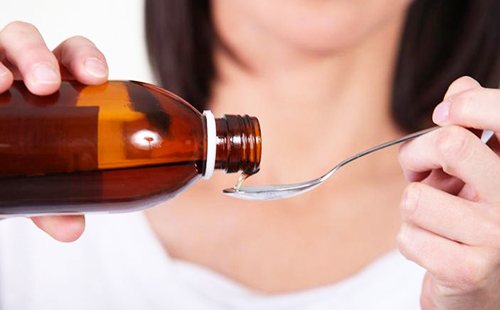

Medicinal properties
Rhizomes are used as a medicinal raw material in badan, which can be harvested throughout the growing season, but it is better to combine this operation with a transplant. Rhizomes are easily pulled out, as they are located on the soil surface. The upper part with a rosette of leaves and a piece of rhizome 5-10 cm long is planted in the ground, and the rest is cleaned of the ground, washed in cold water, cut into small pieces and dried, spreading out in a thin layer on paper. Fast drying in a hot oven can reduce the quality of the raw materials. Raw materials can be stored for up to 4 years.
Leaves are also used in folk medicine. They are harvested at the end of summer, as it is believed that during this period they are more healing. In addition, overwintered brown leaves are used in Altai to prepare a rather pleasant and extremely healthy tea.
Rhizomes contain tannins (15-27%), represented mainly by gallotannins, isocoumarin, bergenin. The leaves contain 13-23% tannins, depending on the age and growing season, vitamin C, rutin, quercetin, dihydroquercetin, polyphenols, phytoncides and up to 22% arbutin glycoside (which is also contained in the lingonberry leaf and gives it medicinal properties). With age, the content of tannins in the leaves decreases, but in the roots, on the contrary, it grows.
In medicine, badan preparations are used as a bactericidal, hemostatic and astringent agent for diseases of the gastrointestinal tract (colitis, diarrhea, bleeding) and in gynecology (colpitis, cervical erosion, uterine bleeding).
The antimicrobial activity of badan is very high, which made it possible to traditionally use it for intestinal infections, in particular, dysentery. Its drugs are active against Escherichia coli and, to a lesser extent, against typhoid fever.
Due to the content of catechins, bergenia preparations have P-vitamin activity, which makes it possible to use them for internal bleeding and bleeding of the gums. And thanks to the combination of antimicrobial and hemostatic action, a badan decoction is a good remedy for periodontal disease.
Relatively recently, a pectin polysaccharide called bergenan was isolated from green leaves of badan, which are used relatively rarely, and it includes d-galacturonic acid and residues of galactose, rhamnose, arabinose and glucose. In an experiment on mice, it was proved that it has an immunostimulating effect, increasing phagocytic activity.
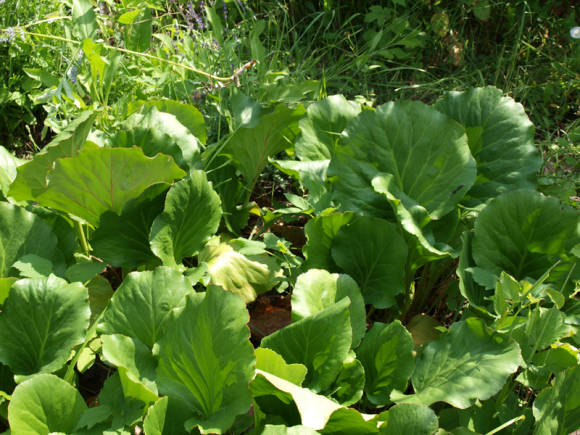

Badan's pick
In May, the first picking of badan seedlings is carried out. They are transplanted into a new box. The distance from one seedling to another should be 5-7 centimeters in a row. But the distance between the rows is 15 centimeters. Decide in advance when you will plant badan in open ground. Since a few weeks before this, hardening of the seedlings should be started. A box with seedlings is taken out to a loggia or balcony. It is better to start with one hour stay there, gradually increasing the time. When the seedlings are on the balcony for a day, you can safely start planting in open ground.
Dosage forms
Decoction
1 tbsp pour 200 ml of thick-leaved bergenia roots. boiling water, bring to a boil and simmer over low heat for half an hour. Remove from heat, cover, wrap and leave to cool. Strain, squeeze the raw material. Bring the resulting liquid to the original volume with boiled water.
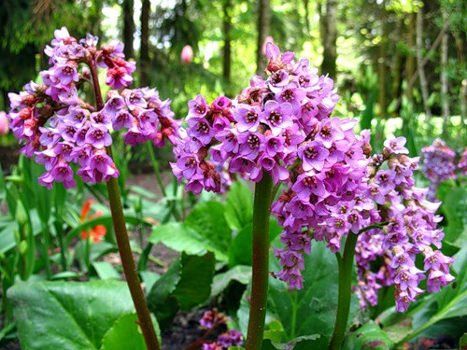

Take 1-2 tbsp. three times a day before meals
Infusion
2 tsp pour 200 ml of crushed leaves or roots of the plant. boiling water, cover, insulate and insist until it cools. Strain, squeeze the raw material.
Take 1 tbsp. 3-4 times a day.
The infusion can be used for both internal and external use.
Liquid extract
3 tbsp Pour 200 ml of berry leaves or roots. boiling water, bring to a boil and simmer over very low heat until the amount of liquid is reduced by half. Remove from heat, cool, squeeze and bring the volume of the resulting liquid with boiled water to 100 ml.
Take 30 drops 2-3 times a day. For douching 15 ml. extract to dilute in 0.5-1 l. boiled water.
Tincture
40-50 gr. Pour 400 ml of chopped roots of bergenia thick-leaved. 70% alcohol or quality vodka. If the tincture is to be used as a skin care product, then 30% vodka should be used.
Close the container tightly with a lid and insist in a dark place at room temperature for a month, shaking well occasionally. Strain, squeeze the raw material well.
For asthma and various lung diseases, drink 20-30 drops per 15 ml. water half an hour before meals twice a day. Also, the tincture is used as rubbing for articular rheumatism, arthritis, arthrosis, periarthritis.
In addition, tincture of bergenia thick-leaved is used in cosmetology for the care of oily skin. To do this, twice a day, you should wipe the skin with a cotton pad soaked in the infusion.
Powder
Grind dry leaves and roots of bergenia with a mixer. Mix well. Store in a glass jar with a lid in a dark, dry place.
Badan after flowering
How and when badan seeds are harvested
Badan produces many seeds, which are approximately 2 mm in size. Choose the largest and most beautiful inflorescence, wait until the flowers begin to fade, and put a gauze bag on the inflorescence so that the ripe seeds do not spill onto the ground. The collection of seeds is carried out in September: the inflorescence is cut below the bag, transferred to a ventilated dry room, dried for several weeks, the seeds are shaken out of the flowers, cleaned and stored.
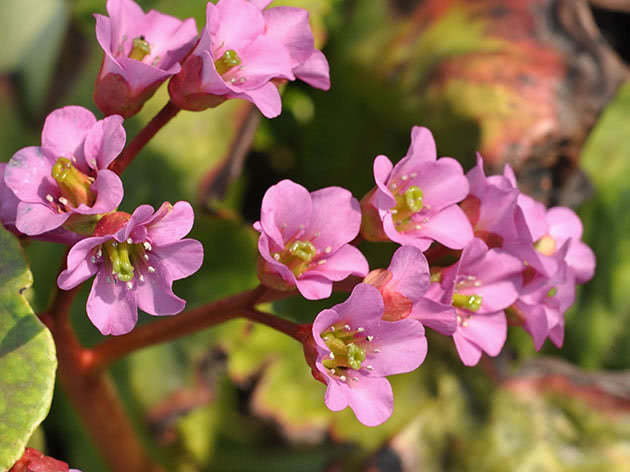

Preparing badan for winter
Some types and varieties of badan, as well as young plants, may suffer from frost - such a badan in the fall should be covered with dry leaves or covered with spruce branches. But the species and varieties of badan, adapted to the conditions of the middle zone, winter well without shelter. Do not prune withered and dried leaves in the fall - this can be done in the spring.
Leaves
In winter and summer, leaves are preserved on the plant. In summer they are deep green in color. They are large, leathery, rather thick, oval in shape. Multi-point veins can be seen on the underside of the plate. By autumn, the leaves turn fiery orange.
Interestingly, the winter leaves of the plant are considered a more effective healing raw material. For a long time, the indigenous population of Gorny Altai has been using them as a kind of surrogate for tea, which is considered a man's drink there. Therefore, advice for summer residents who have thick-leaved berry growing on the plot: do not pick off brownish, yellowed leaves and do not throw them away - they can be used to make healthy tea.
Where does it grow?
Badan grows more often in places with a temperate climate in the northern part of the land. Moreover, this perennial grows, mainly in Asia, more often in Altai, Siberia, Korea and other regions.
It often grows in a variety of natural conditions: it can often grow in a coniferous forest and a broad-leaved or mixed forest, a forest-steppe zone or in meadows in mountainous regions. Often found in alpine meadows.
However, if saxifrage is planted in the sun in a flower garden, then its development will be slow. The perennial should be planted in partial shade, although some varieties of badan prefer to grow on a hill. If you plant a saxifrage in a lowland, where it is constantly damp, then it will not bloom, and if it blooms, then it is bad.
Features of growing a perennial plant
Badan is not the most capricious plant, therefore, not only an experienced gardener, but also a beginner can cope with it. It can be grown almost throughout the entire territory of our country, however, in hot, arid regions, care will be complicated by frequent watering. In this case, it is better to plant it in partial shade - under trees or on the north side of the building. In general, badan can withstand summer temperatures up to +30 o C and above, the main thing is that in hot weather it receives enough moisture and is shaded at midday.
Landing in open ground
Finding the right spot in the garden is important for good growth and flowering. Here the opinions of experts differ - some believe that a sunny area is needed for flowering, others advocate partial shade. And here only personal experience will become the best advisor.
When choosing a place for badan, as for any other plant, it is necessary to take into account the local climate. For example, a sunny site in Siberia or in the Moscow region is quite a comfortable place for many species of plants, at the same time, not every weed will withstand the sun in the South Urals. Therefore, when choosing a place for a plant, you need to make an amendment to the climatic conditions - in the steppe zone with scorching sun and dry winds, it is better if the site is shaded, ideally near a pond, in a temperate climate the sun or partial shade is suitable.
Badan prefers light, loose soil. The fact is that the powerful rhizome of the plant lies close to the surface and such a soil structure will provide it with the necessary moisture and nutrients. Sometimes the roots are too close and even go out, so the ground around it needs to be mulched, especially in sunny places. The composition of the soil does not really matter, but waterlogging should be avoided. You cannot plant a flower in places with possible spring flooding.
Planting and growing badan in pots
Bergenia planted in tubs or pots is a real decoration of the summer garden. The plant develops well and blooms in a container, moreover, it can be easily moved if the chosen place turned out to be unsuccessful.
To plant in a flower pot or tub, you must:
- Pour drainage on the bottom of the planter - expanded clay, pebbles or crushed stone, by ¼ of the volume.
- Fill half of the container with the prepared mixture - turf soil, leafy soil, compost, sand in a ratio of 2: 2: 1: 1.
- Place the prepared berry socket in the center (if it is not planted in the composition) and cover it with the rest of the earth.
- Squeeze the soil lightly around the plant and water.
- Cover the surface with bark, pebbles or decorative gravel.
When choosing a planter or tub for bergenia, you need to make sure there are good drainage holes. So that they do not get clogged with earth during irrigation, shards are laid on the bottom, and already on top - a layer of drainage.


Planted in a flowerpot, badan feels no worse than in a flower bed
For the winter, a pots or tub with a flower must be transferred to a greenhouse or veranda and covered with lutrasil. Plants grown in the southern regions where the frost does not fall below 5 ° C can winter in containers outside. In all other regions, there is a threat of cracking the pot from frost and freezing of the roots.
Where else is badan used?
Bergenia thick-leaved is a melliferous plant. Her flowers attract florists because they keep well and are suitable for creating original compositions from dried flowers. In addition, drugs based on badan are used in veterinary medicine.
The thick-leaved saxifrage is widely used as an ornamental plant for landscaping parks and squares. In landscape design, it is used to decorate borders, independent plantings, looks great near pools and other bodies of water, near stones.
Badan is a recognized tanning agent: the content of tannins in it is twice as much as in the bark of willow or spruce, and four times as much as in oak bark. Natural dyes are made from this plant: brown, black.
Badan Schmidt (V. x schmidtii, or B. stracheyi var. Schmidtii)
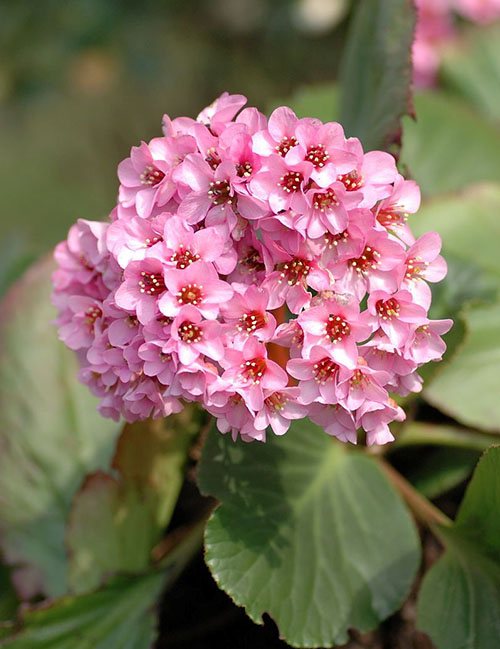

Hybrid badans from cross-pollination of plants of different species were first obtained in the 19th century. An example of such a culture is Schmidt's badan, which has absorbed the features of thick-leaved and ciliated badan.
This plant is easily distinguished from other varieties by its glossy leaves with jagged edges. Dense leaf plates are preserved under the snow. In the spring, when flower shoots appear above them, foliage growth stops, and resumes with wilting of inflorescences and the formation of seed bolls.
White, purple or pink flowers up to 5 mm in diameter open from May to July or August. In the fall, seeds ripen, which can be sown immediately to obtain spring seedlings.
The care the plant needs
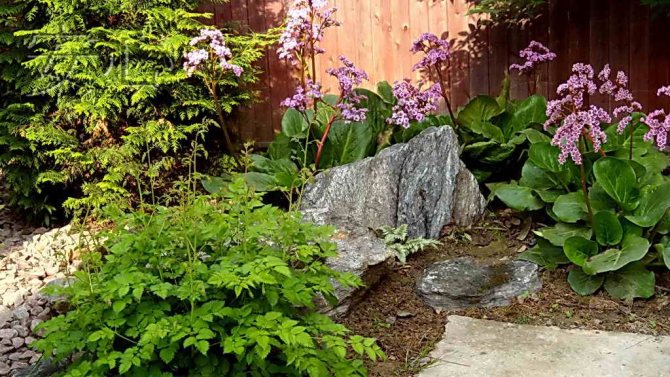

The plant itself is unpretentious, care consists only in creating a natural habitat for the flower. But it is easier for bergamo to create it than other plants. Immediately it is worth considering that the berry grows slowly, and the first flowers appear only in the second year. With the onset of autumn, berry must be prepared for winter - cut off dry inflorescences, and in spring - remove overwintered leaves. Also, in order to grow a beautiful and lush flower in the first year, it is imperative to mulch the soil.
Flowers do not like being poured with moisture, so watering should be regular, but not plentiful. Fallen leaves around the stem do not need to be thoroughly removed - they help the berry to regulate humidity on its own. If you do not want to see the leaves on the site, due to a violation of aesthetics, then the soil should be mulched. Take into account that the soil must not be overdried. In one and the same place, without transplants, berry can grow and bloom flowers for 10 years. For the winter period, the rhizomes are not dug out - the bergenia tolerates winters well in the ground.
Collection of badan seeds
After flowering, badan produces quite a lot of small seeds. For reproduction, it is better to choose the largest and most lush inflorescences. A gauze bag is put on the withering flowers so that when they ripen, the seeds do not fall to the ground. Seeds are usually harvested in September. Just below the place where the bag is tied, you need to cut off the selected inflorescence and bring it into a dry room. There, the seeds need to be dried for several weeks.After that, they are taken out of the seed pods, cleaned of excess debris and poisoned for storage in a dry place.
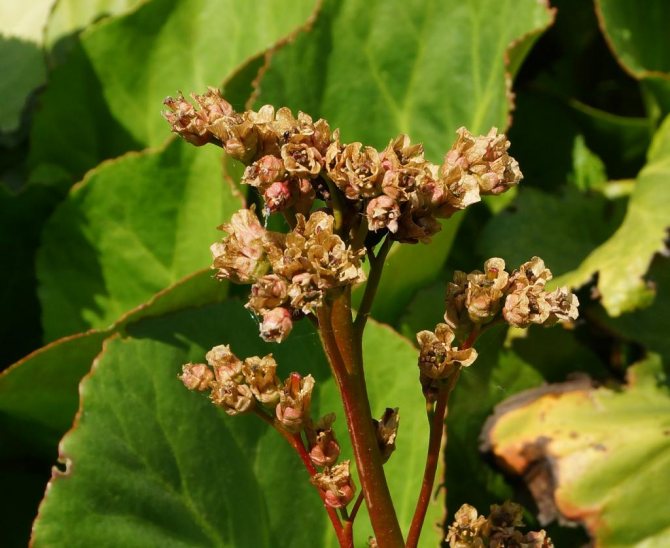

Popular species and varieties
Badan has 10 species with many varieties that differ in size, color and leaf shape. Flowering is also different in terms of timing and effectiveness - there are forms with double and semi-double flowers of original colors.
Heart-leaved badan is the most popular species, native to Altai. The plant is undersized, no more than 40 cm in height, with thick, dark green, heart-shaped leaves. Bell-shaped flowers of white, pink, lilac and lilac colors. Flowering begins in May and lasts 20 days. This is a very frost-resistant species - the leaves overwintering under the snow can withstand temperatures down to -40 o C.
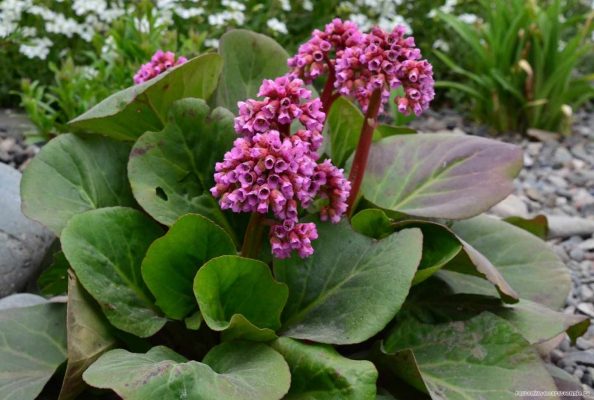

One of the most frost-hardy species is heart-leaved berry
Badan thick-leaved is found in Altai, Sayan and Mongolia. An evergreen herb grows up to 60 cm in height. Glossy leathery leaves of a rounded shape are collected in a dense rosette. The paniculate inflorescence consists of numerous bell flowers of a delicate pink or lilac color. Badan thick-leaved is distinguished by early flowering - from the end of April to June. The decorative effect is preserved all summer thanks to the juicy leaves, some of which turn red by autumn, enhancing the showiness of the plant. Winter-hardy view - the foliage does not change color under the snow and the plant meets the spring with green and purple colors.
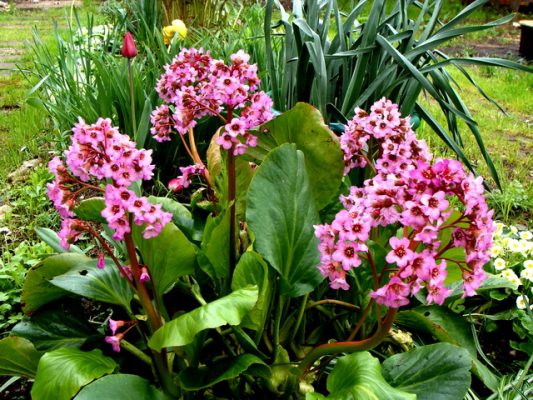

Badan thick-leaved - a large plant with shiny leaves and luxurious flowers
The Galina Serova variety is attractive due to the variegated color of the leaves and for the same reason prefers a sunny location. The large leathery berry leaves with white strokes are adorable throughout the summer, and in the fall, when the green color changes to red, a fireworks effect is created in the garden. It blooms in May-June with bell-shaped pink flowers. Winters well under the snow.
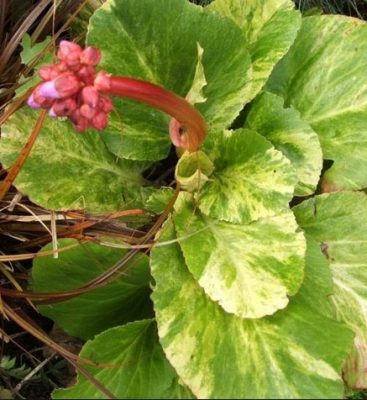

Galina Serova is a rare variety of badan, characterized by variegated leaf color
In Europe, Schmidt's badan is most popular. Differs from other varieties with matte large leaves and the presence of a kind of "wings" growing from the center of the rosette. Bright pink flowers are collected in a spherical inflorescence on a low peduncle. The plant is winter-hardy, unpretentious, blooms in May-June, but retains its decorative effect throughout the summer.
Badan Bressingham White is a hybrid, shade-tolerant variety. It prefers moist places, but does not impose any special requirements on the composition of the soil. Large, dark green glossy leaves form a rosette 30 cm high. White flowers are collected in loose inflorescences. Blooms in May – June. Frost-resistant variety.


Bressingham White is a hybrid grape variety with spectacular white flowers
Badan Abenglut is a shade-tolerant, unpretentious, frost-resistant variety. Planting in sunny places withstands, but does not grow magnificently, besides, in bright light, the flowering period is shortened. Bright green leaves, collected in a low rosette, acquire a beautiful bronze tint in autumn. Purple semi-double flowers on thick red peduncles delight the eye from April to May.
Badan Abenglut attracts attention with bright semi-double flowers
Seed propagation
You can also grow berry seeds from seeds. They are first sown in a container or box, and when they grow up, they are transplanted into the ground. And so fewer sprouted plants will die. When the seedlings grow up to 11-13 cm, they are planted on a flower garden. But only such plants grow from seeds for a very long time. Also, not all plants can sprout. In order for the percentage of germination to be higher, it is recommended to immerse the seeds in the fungicide solution for a short time before sowing. This will not only help the seeds germinate better, but also prevent the appearance of diseases.
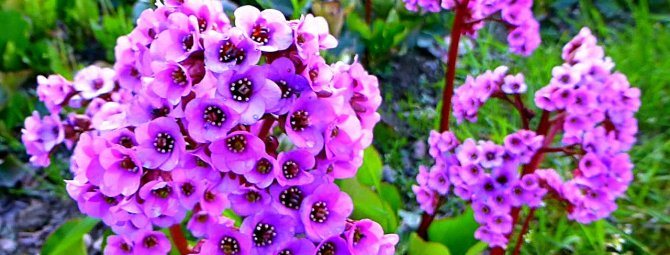

Badan can become a real decoration of a country garden.This amazing herbaceous shrub with a long peduncle covered with numerous flowers is beautiful from the first days of spring to late autumn. Its leaves are bright, juicy, in some varieties, huge, like burdocks - they can turn any corner of the garden into a fairy tale - be it a pond, a rocky hill or a modest garden path. It's also nice that planting a plant in open ground and caring for it will not be a difficult task for a beginner.
Reproduction vegetatively
The best time to propagate a plant in this way is the end of flowering. This usually happens in the fall. The roots of the plant, despite their length, do not go deep, but spread close to the surface. Small bushes often begin to grow on them, which are planted. They can be easily dug up along with the roots. It is only important not to damage the root, for which it is necessary to loosen the earth properly. Planting seedlings should be accompanied by root sterilization. This is done with bleach made from bleach or manganese solution. Prepare a solution of manganese diluted in water in a ratio of 1:10. Bleach is also diluted approximately. After processing the seedlings, they are planted in the holes. If there are many sprouts, you can dig not holes, but a trench.
The second method is even simpler: reproduction by dividing the bushes. To separate a part of the plant, it is recommended to separate the young roots. Reproduction by this method is not a problem for the reason that new roots are closest to the surface in the soil and are easier to dig out. The division of the bush and the planting of parts is usually done in May - June.
In order for division and planting to be successful, each root must have at least four root buds and at least two leaves. The separated parts are planted in pre-prepared holes no more than 11 cm deep. Adjacent holes are placed at a distance of about 35 cm from each other. After planting the bushes, the ground needs to be well watered. So the plant is divided no more than once every four years.
Disembarkation rules
So, how do berry planting in the garden and care for the planted seedlings take place?
The berry's root system is rather weak, located horizontally. Therefore, for planting seedlings, you should choose a loose and light alkaline soil. Quite often, it happens that the roots of bergenia begin to look out of the ground. This should be considered in advance, as in this position they can overheat in the sun. To prevent this from happening, a shaded area should be chosen for planting badan. Better if it will be the northern, northeastern or northwestern part of your site. If you cannot plant an incense in such a place, then immediately after planting, lay a layer of mulch in the root zone. This will allow the soil to dry out more slowly and the root system will be protected from sunlight. Be sure to take into account the fact that moisture should never stagnate in the roots of incense. He can't stand it.
So, goes directly to the disembarkation of badan. It is necessary to make holes in the soil, the depth of which should be 6-8 centimeters. It is better to arrange them in a checkerboard pattern. The bottom of each hole should be covered with a layer of sand that will act as drainage. Seedlings are transferred into holes directly with an earthen clod and immediately added. Immediately after planting the seedlings, it is necessary to water the beds. The development and growth of badan is rather slow, so you have to be patient. In the first two years of flowering, you can not wait. Badan usually blooms in the fourth year after planting in open ground.
Seedling berry
Within three weeks after you bring the box of incense into the house, the first shoots will appear. It is not difficult to take care of bergenia seedlings. It is necessary to periodically loosen the soil and conduct timely watering. But remember that you need to moisten the soil only when its top layer is dry.Also, do not forget to ventilate the room and remove weak seedlings so that they do not interfere with the development of stronger ones. Sometimes it happens that a green crust appears on the surface of the earth. It indicates that the root system receives too much water, and because of this, oxygen stops flowing to the roots.


The main characteristics of the plant
Badan is an evergreen herb of the saxifrage family. Its Latin name - Bergenia received in honor of the German scientist botanist Karl Bergen. Large fleshy leaves resemble elephant ears in shape, hence the common name of the plant - elephant ears.
A native of Asia, in nature the flower is found in meadows, and in lowlands, and among rocky placers. Its unpretentiousness to growing conditions played an important role in the creation of cultivars.
Badan leaves are collected in a dense rosette. The root system is powerful but superficial. During flowering, several long bare peduncles appear, strewn with numerous goblet flowers. Flowers, with a diameter of about 2 cm, have, depending on the variety, different colors - from white to bright pink.


One of the first plants to bloom in the garden in spring
Medicinal properties of badan
Badan rosettes have not only decorative value. From overwintered blackened leaves, you can brew delicious, aromatic tea. In Siberia, such a drink, and the badan itself, is called Mongolian tea, and in Altai it is called Chigir tea. Regardless of the name, the brewed leaves help lower blood pressure, normalize the gastrointestinal tract, cleanse blood vessels and boost immunity. Thanks to the tannins contained in the plant, Mongolian tea is used for intestinal disorders.
Growing conditions
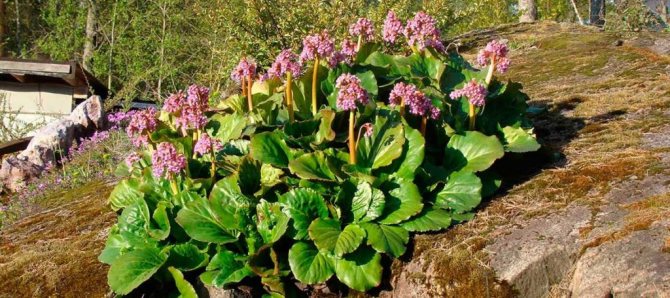

The perennial is not picky about the nutritional value of soils, but it feels more comfortable in neutral or slightly alkaline soils and on stony mountain slopes, settling in the cracks between stone slabs. Moreover, he needs a normal water regime and drainage. Perennial is resistant to droughts, temperature extremes. Easily tolerates frost, but if temperature changes occur in winter or early spring, flower buds or blooming flowers may die. To prevent this from happening, young plants need to be insulated during frosts. If the spring is too hot, young leaves, which were planted in insufficiently shaded places, may begin to burn in a bright, sunny place. The plant must be protected from hot rays. The plant needs such care so that it is not burned by hot rays and the roots are not damaged by high humidity.
In winter, the wind can also damage the bushes. The most sensitive parts of this plant are the leaves. They bind when planting plants in dry soil. Therefore, you need to shelter the plant from the wind and sunlight, not only in winter. You can plant berry bushes on the north side of the house or against the wall of the fence. But better on the northwest or northeast sides. They will be very comfortable there: the direct rays of the sun will not burn the leaves, and the wall will protect them from the wind. It should be remembered that in the complete absence of the sun, the plant may not bloom. It would be nice if the planting is carried out on an elevated place near such a wall or in a stone garden next to the same plants that do not like the sun.
Healing tea
Such a drink can be prepared by mixing your favorite black tea with overwintered dry berry leaves. This tea relieves fatigue, has a powerful tonic and immunomodulatory effect. It should be noted that thick-leaved incense is brewed longer than black tea, since its leaves are much thicker than tea leaves. Therefore, in order for the active substances to more actively pass into the infusion, they can be brought to a boil and turned off immediately. Then mix the composition with traditionally brewed black tea.
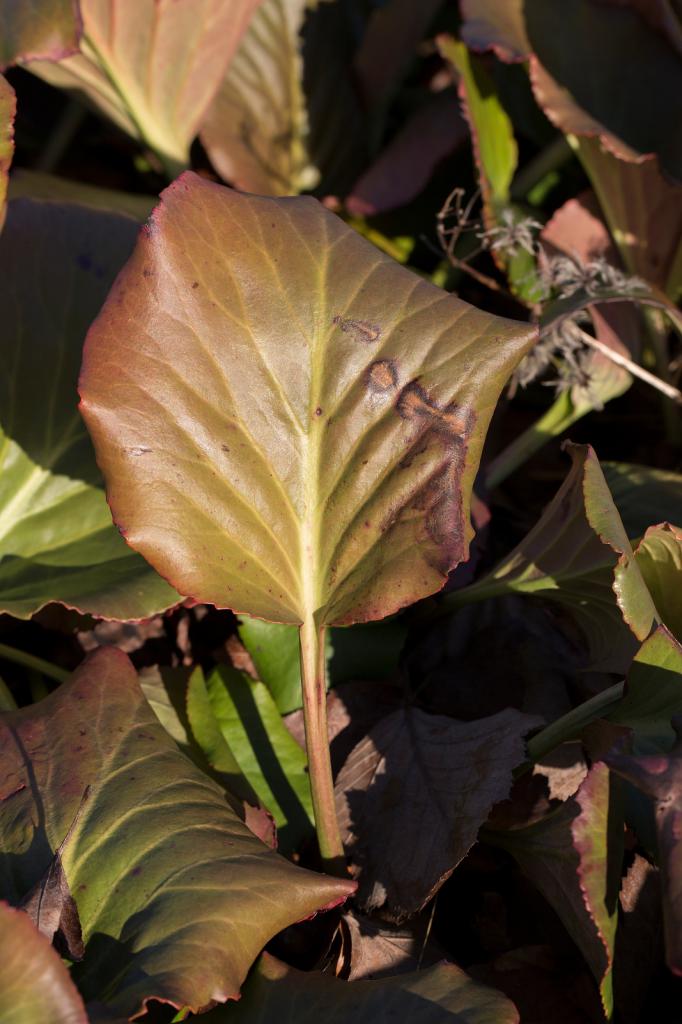

Winter berry leaves can be brewed separately. To do this, pour 250 ml of boiling water over one teaspoon (teaspoon) of dry leaves. Let the composition brew and drink it like regular tea (you can also cold) for diseases of the gastrointestinal tract, kidneys, to lower blood pressure, strengthen the walls of the capillaries.
Sowing seeds
Sowing incense is recommended before winter. Choose a suitable box and fill it with flower soil. Further, grooves must be made in the soil, the depth of which should not exceed five millimeters. The distance from one groove to the other should be three centimeters. After they are ready, spill them with warm water, and then lay out the seeds and immediately sprinkle with soil. After disembarking, the box must be taken outside and placed under the snow. At the beginning of March, it will need to be brought indoors and placed in partial shade. The air temperature in the room should not fall below + 18-19 degrees.
Further care
A properly planted perennial badan, growing and caring in the future, will not take much time:
- in the absence of precipitation in the warm season, badan is watered no more than 1 time per week;
- in order to preserve the decorative appearance of the plantings, it is recommended to remove weeds; for preventive purposes, the aisles are mulched with peat, humus;
- after flowering, dried inflorescences are removed;
- in the spring, the old overwintered leaves of the plant are cut;
- in order for the plants to develop well, it is necessary to thin out the bushes in a timely manner.
Important! After transplanting, the perennial takes root for a long time in a new place. During this period, the condition of the soil is closely monitored, maintaining it in a moderately moist state.
Use in landscape design
Colorful varieties of badan are applicable for the formation of multi-level flower beds of medium and large sizes. Badan is planted more often at the foot or at the penultimate step. In the shade, the culture produces juicy and large foliage, in the sun it pleases with abundant flowering, the leaves are less lush.
The perennial shows itself in the best way when decorating paths, the foreground of flower beds and flower beds, as an evergreen ground cover, an element of large mixborders. Saxifrage is also used as a tapeworm, placing the plant against the background of a well-groomed emerald lawn. In the fall, culture draws attention to the swings of greens and reds.
With proper care, badan actively grows and pleases with colorful flowering.
Fertilization
In the wild, badan does without fertilizers, however, cultivated varieties have higher decorative properties and to maintain bright flowering, as well as the general attractive appearance of the badan plant, planting and care in the open field includes not only pre-sowing soil fertilization, but also fertilizing throughout life flower.
For this, mineral dressings are used:
- in spring, universal fertilizer for garden flowers is applied to the beds;
- in the fall, planting is watered with a superphosphate solution at the rate of 20 g per bucket of water for irrigation 1 sq. m plot.


